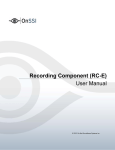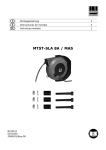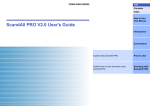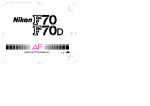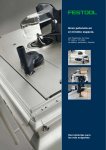Download NetCam SC - Security Merchants
Transcript
NetCam SC
User’s Manual
w w w.stardot .com
Table of Contents
Chapter 1 Configuration..........................................................................5
1.1
1.2
1.3
1.4
1.5
Before You Start........................................................................5
What’s Included and What’s Required......................................5
Parts of NetCam SC.................................................................6
Connecting NetCam SC to a Network......................................6
An Overview of Network Connectivity.......................................7
Chapter 2 Installation...............................................................................9
2.1 Installing NetCam SC................................................................9
2.2 Outdoor Environment................................................................9
Chapter 3 Accessing NetCam SC.........................................................10
3.1 Viewing NetCam SC’s Images................................................10
3.2 NetCam SC’s Configuration Menus........................................ 11
3.3 Image Properties..................................................................... 11
3.4 Overlay Properties..................................................................17
3.5 FTP Properties........................................................................20
3.7 Date/Time Properties..............................................................24
3.8 Network Properties.................................................................26
3.9 Dial-Out Properties.................................................................28
3.10 Security Properties..................................................................30
3.11 Advanced Menus....................................................................31
3.12 Miscellaneous.........................................................................31
3.13 Manual Config.........................................................................31
3.14 PTZ.........................................................................................31
3.15 Dynamic DNS.........................................................................31
3.16 Trigger Properties...................................................................32
3.17 Weather Station......................................................................36
Chapter 4 Imaging Tips..........................................................................37
4.1 Lighting...................................................................................37
4.2 Image Processing Options......................................................38
Chapter 5 Lenses....................................................................................40
Troubleshooting Guide............................................................................42
Technical Support....................................................................................42
Specifications...........................................................................................43
Page NetCam SC
Chapter 1
Configuration
Congratulations on your purchase of a StarDot NetCam SC network camera with
integrated web server. The NetCam SC combines the best of the analog CCTV world
(auto iris, day/night IR filter*, video out, 24VAC/12VC power inputs, I/O) with the
best of the digital IP camera world (up to 5 megapixel, Power over Ethernet, integrated
video motion detection).
With proper usage, NetCam SC will provide many years of quality video. We
recommend that you read this manual carefully to completely understand the camera’s
capabilities. Throughout this manual, your NetCam SC camera will also be referred
to as simply NetCam.
* Day/night IR filter available only on IR models.
1.1 Before You Start
This manual guides you through the basic setup procedure for the
NetCam SC and provides a detailed resource of the camera’s advanced
options and capabilities.
Setting up NetCam SC consists of three steps. The first step is to
configure the network settings. The second step is to configure NetCam to
upload images to a web server (this step is optional). The third step is the
physical installation of the camera.
1.2 What’s Included and What’s Required
The basic package includes a NetCam SC camera, a lens and the
StarDot Tools software (and this manual) on CD-ROM. Since the NetCam
SC is a PoE device (Power over Ethernet), it is assumed that most users
will provide their own CAT 5 or CAT 6 cable, as well as a PoE switch or
power injector. StarDot optionally offers a wall mount, a power supply, a
combination network/power cable and a null serial configuration cable. In
order to use the NetCam SC, you will need the following:
•
Power source (PoE, 12VDC or 24VAC)
•
A computer – for configuring NetCam SC and for viewing video
(viewing requires Java or ActiveX-enabled web browser)
Note: A computer is not necessary to operate NetCam, only to configure it.
•
NetCam SC
Network connectivity (LAN, cable modem, DSL, T-1, Dial-Up
Internet Account, Satellite Modem, etc.)
Page 1.3 Parts of NetCam SC
Auto Iris Jack (not shown)
For connecting DC auto iris lens
S1 (Aux)
RS-232 Port, Optional Serial Configuration
Auxilliary Device Control
24VAC
Useful for legacy CCTV
Power Infrastructure
Star
Te
c
hn
S1
Dot
ol o
AC
24V
gie
EO
VID
s
I/O
T
NE
E)
(Po
NET (PoE) 802.3af
100Mbit Power over Ethernet Port
X)
(AU
3
DC
12V
4
2
1
PWR (DC Power Jack)
10-20VDC (500mA @ 12VDC)
VIDEO OUT
Analog Video
(NTSC or PAL)
I/O (Input/Output)
Alarm Trigger Input / Relay Output
1.4 Connecting NetCam SC to a Network
The StarDot Tools software can be used to find the camera’s IP address
or to configure the camera with the Setup Wizard (optional).
Install the StarDot Tools software by inserting the CD-ROM and
running setup.exe (it should run automatically).
If your network has a router or server that auto assigns IP addresses
(DHCP), StarDot Tools will find the camera’s IP address and display
it in the software. To access NetCam SC, simply double-click its IP
address. If the IP address is displayed, skip to Chapter 3.
If your network does not auto-assign IP addresses, you can assign a
manual IP using a null serial cable. Connect one end of a null model
serial cable to the S1 port of NetCam SC and the other end into an
available serial port on your PC.
Connect NetCam SC into a PoE switch or injector with a standard
CAT 5 network cable or with a StarDot Combo Ethernet/Power
Cable.
In StarDot Tools, click the Setup Wizard button.
Follow the steps in the Setup Wizard. If you’re unsure of some of
the answers or you’d like more information on connecting NetCam
to the Internet or your private network, read the next section,
“An Overview of NetCam SC Connectivity”.
Page NetCam SC
1.5 An Overview of Network Connectivity
A LAN or network connection is the simplest configuration for
NetCam SC. NetCam SC simply needs an IP address (and other networking
parameters) to make the live images and configuration menus accessible
from any web browser on the network. There are two ways NetCam SC
can be assigned an IP address: automatically or manually.
Automatic IP Assignment (DHCP)
NetCam SC is shipped in an automatic IP assignment mode called
DHCP (Dynamic Host Configuration Protocol). If your network has a DHCP
server (in most cases, a router), it will automatically assign the necessary
network parameters to NetCam SC. Before you can access the camera, you
will need to know which IP address was assigned. Use the StarDot Tools
software to find the camera’s IP address.
Manual IP Assignment
If you want to assign the camera a permanent IP address, you will need
the following information:
•
•
•
•
IP Address (example: 192.168.1.5)
Subnet Mask (example: 255.255.255.0)
Gateway (example: 192.168.1.1)
DNS Servers (obtain from ISP)
If you are installing the camera on a company network, you will probably
want to get this information from the system administrator.
The easiest way to configure NetCam SC manually is to connect the
camera to a serial port on your computer. Plug one end of a null modem serial
cable into the S1 port on the back of NetCam SC and the other end into an
available 9-pin serial port on the back of your computer. Use the included
StarDot Tools software to configure the camera using the Setup Wizard.
If you don’t have a serial port or are using a non-Windows machine,
you have a few options.
If NetCam SC is connected to a network with a DHCP server and your
computer is not running Windows, you can log into your router (or whatever
is acting as your DHCP server) and view the DHCP clients table. NetCam
SC will have a MAC address starting with 00:30:F4. Take note of the IP
address and enter it in your web browser. Click on the configuration link,
visit the network tab and assign the camera a manual IP address (outside
of the router’s DHCP range).
If NetCam SC is connected to a network without a DHCP server
(IP addresses are not automatically assigned) and your computer is not
NetCam SC
Page running Windows, you’ll have to manually assign the camera an IP address.
This requires terminal emulation software and the included null serial cable.
On a Macintosh or on a Windows computer without a serial port, you’ll
need a USB RS-232 adapter.
To talk directly to the camera via the included serial cable, set your
terminal software to a bitrate of 38,400 (8/N/1). Log in with username
admin, password admin and use the following commands to assign the
camera a temporary IP address. Once the IP has been assigned, browse to the
camera with a web browser and configure NetCam SC so it has a permanent
static IP address (see Chapter 3.8).
In the following example, NetCam SC is being assigned a temporary
IP address of 192.168.0.2 via a terminal program connected to the S1 port
on the back of NetCam SC:
ifconfig eth0 192.168.0.2
route add -net 192.168.0.0 netmask 255.255.255.0 eth0
Remember, once you can reach camera via its temporary IP address,
you’ll want to immediately assign it a permanent static IP address in the
network configuration menu.
Page NetCam SC
Chapter 2
Installation
Before installing the camera in its final location, it is important to
configure and test it first (see Chapter 1).
2.1 Installing NetCam SC
Measure the distance from the camera to the nearest Ethernet hub or
switch. This distance should not exceed 330 feet. If you wish to extend the
distance further than 330 feet, you can add an Ethernet hub or switch.
There are three ways to power NetCam SC. This allows you go install
the camera in virtually any existing infrastructure. NOTE: Only use one
method to power the camera . Do not plug two or more power sources
into the camera simultaneously.
Power over Ethernet (PoE)
Run standard CAT 5 or better Ethernet cable from a PoE hub/switch
(or PoE power injector) into the NET jack on the back of NetCam SC.
NetCam SC will run off the PoE power running in the CAT 5 cable. No
other power source is required.
Separate Ethernet and Power
If you decide not to use PoE, you can connect one end of a CAT 5 or
better Ethernet cable into a hub/switch and the other end into the NET jack
on the back of NetCam SC. Plug a 12VDC 1A power supply into the back
of NetCam SC (or you may use a 24VAC power supply and connect it to
the input marked 24VAC).
StarDot’s Power/Network Cable
If you choose not to power NetCam SC via PoE and you still want
the take advantage of a single cable run, StarDot provides Power/Network
cable that allows you to run both power and data in the same cable. Visit
http://www.stardot.com for more information.
2.2 Outdoor Environment
To mount NetCam SC outdoors, it must first be encased in an outdoor
enclosure (different models are available from StarDot Technologies, see
http://www.stardot.com/sc). Install the camera in an outdoor enclosure and
adjust the internal mount so the lens is up against the enclosure window.
This helps to reduce glare and interior reflections.
Determine where NetCam SC will be pointing and where you’d like to
mount it. The outdoor enclosure can be mounted on a horizontal or vertical
surface. When aiming the camera, factors such as sun travel and amount
of visible sky can vastly affect the quality of the image. For imaging tips,
see Section 4.1.
NetCam SC
Page Chapter 3
Accessing NetCam SC
3.1 Viewing NetCam SC’s Images
Any Java-enabled browser can be used to view the live images.
Type NetCam SC’s IP address in your browser’s address bar (example:
http://192.168.1.5). Or use StarDot Tools to Find the camera’s IP
address.
Window Size
For most viewing, the window size should be set to 100%, which is a
pixel to pixel match of the image resolution. If you select 50%, the width
and height will be browser resized to 50% of the actual image resolution. If
you select 200%, the width and height will be browser resized to 200% of
the actual image resolution. This does not affect the actual image resolution
which is set on the image configuration menu (Section 3.3).
Mode
This determines which method is used to watch the live video:
Pull - Java applet “pulls” the live images via web port (usually 80)
Push - Java applet receives motion JPEG stream via port 8001
ActiveX - receives motion JPEG stream via port 8001
.NET - receives motion JPEG stream via web port (usually 80)
Page 10
NetCam SC
3.2 NetCam SC’s Configuration Menus
Virtually any web browser can be used to access NetCam SC’s
configuration menus. To access these menus, type NetCam SC’s IP address
in your browser’s address bar (example: http://192.168.1.5). This
will bring up the live image page. Click on the Configuration link. You will
be prompted for a User Name and Password. Use admin for both.
Tip:
We highly recommend that you change the default password. To do so, see
Section 3.10.
3.3 Image Properties
All image-related configuration options are located on the Image
Properties page. After making changes, click the Apply button to save new
settings in the camera. Each section can be collapsed and expanded. If a
section is collapsed, click to expand.
NetCam SC
Page 11
PROCESSING
Resolution
Resolution is the dimensional size of the NetCam SC image, measured
in pixels, horizontal by vertical. The higher the resolution, the larger the
picture appears in your browser, and the longer it takes to download. Some
resolutions, such as portrait and HD, crop the image. The resolution marked
with an asterisk (*) denotes the default quarter resolution image.
Tip:
As with most digital cameras, NetCam SC achieves the highest quality and
clearest images at quarter resolution. This is due to the way color is calculated
with digital image sensors. The largest “high quality” image on the NetCam SC
5MP is 1296x960.
Saturation
This represents the amount of color in the image. The higher the number,
the more saturated the color.
Haze
This represents the amount of haze subtraction. The higher the value,
the more haze is subtracted and the image results in higher contrast.
Using the Auto Haze function is recommended over setting the haze
manually.
Auto Haze
Haze subtraction is automatically determined by the camera.
Enabling Auto Haze is recommended.
JPEG Quality
The JPEG Quality is a balance between lossy image compression
and image quality. The higher the number, the less compression artifacts
in the image, but the bigger the file size. A value higher than 90 is not
recommended, as it greatly increases the file size with very little
noticeable difference in image quality.
Sharpen
When enabled, software sharpening is performed on the live image.
For the best image quality, Sharpen should be enabled.
EXPOSURE
Auto vs. Manual
Unless you have a controlled (fixed) lighting condition, you will almost
always want to leave Auto Exposure enabled.
Auto Exposure
Enabling Auto Exposure causes NetCam SC to automatically
adjust the image exposure based on the overall brightness of the image.
Page 12
NetCam SC
The following functions are only implemented when Auto Exposure is
enabled.
•
Brightness - The higher the number, the brighter the picture. This
is the target for the auto exposure code.
•
Sync- Fluorescent lighting refreshes at 60Hz or 50Hz, depending
on what country you live in. This may interfere with the camera’s
exposure. Set the sync to the appropriate value for your area
(example: U.S. is 60Hz). If you are pointing the camera outdoors or
do not use fluorescent lighting, turn this option off.
Manual Exposure
Enabling Manual Exposure causes the camera to expose images at
the value placed in the Exposure field. Keep in mind that using manual
exposure is not advised for outdoor imaging, since the light conditions are
constantly changing. You may opt to use manual exposure indoors if your
lighting conditions do not change. Here are some sample values and their
fractional and decimal equivalents:
48 = 1/1000 second (0.0001)
96 = 1/500 second (0.002)
248 = 1/200 second (0.005)
480 = 1/100 second (0.01)
800 = 1/60 second (0.1666)
960 = 1/50 second (0.020)
1600 = 1/30 second (0.0333)
3200 = 1/15 second (0.0666)*
6000 = 1/8 second (0.125)*
12000 = 1/4 second (0.25)*
24000 = 1/2 second (0.5)*
32767 = 0.68 seconds (maximum exposure)*
* may introduce pixel noise
EXPOSURE GRID
When Auto Exposure is enabled, NetCam SC adjusts the exposure
of the image based on the average brightness of the pixels located in
the selected regions in the Exposure Grid. If you want the camera to
determine the exposure based on only the sky, you would select the
squares that apply to the sky (click the View Grid button to see the grid
over the image). Conversely, if you’d like the exposure to be determined
by the foreground, select only those squares. This is comparable to the
spot exposure on a traditional camera.
ADVANCED
•
NetCam SC
Auto Iris- Only enable this option if a DC Auto Iris lens is
connected into the camera. If your camera does have a DC Auto
Iris lens connected, you may optionally enable this option when the
Page 13
camera is pointing outdoors.
•
Back Light - Backlight compensation (BLC) adjusts the picture in
situations where a bright light source, such as window, is causing the
image to be improperly exposed.
•
Low Light Presets - There are a lot of controls in determining
how the camera behaves in low light conditions. To simplify low
light use, a number of Low Light Presets are available to instantly
configure the camera as required. The presets automatically set
all the other controls. If you’d like to manually set the advanced
controls select “Manual” in the Low Light Presets dropdown.
•
Exposure Limit - The camera will not expose the image sensor
above this value. The default is 32767 (about 0.7 seconds). A higher
value will make the camera more light sensitive in low light at the
expense of motion blur.
•
Allow Extended Exposures - In darker lighting conditions, a
longer exposure produces a brighter image. A longer exposure also
produces an image where objects in motion may appear blurry. If
your application requires the best possible image quality and motion
blur is not a concern, enable Allow Extended Exposures and set the
Exposure Limit to a high value (up to 32767). If your application
requires capturing images of people or objects in motion, disable
Allow Extended Exposures.
•
Automatic Gain Control (AGC) - The picture is digitally
amplified in low light conditions or in situations where the exposure
is limited to reduce motion blur. Enabling AGC may introduce image
noise.
•
AGC Limit - The higher the limit, the more digital amplification
occurs (assuming it’s necessary). If you want to limit the digital gain
to reduce noise on the image, reduce this value.
•
Low Light - In low light conditions, the analog low light mode of
the image sensor is enabled. Enabling Low Light may introduce
image noise.
•
Pixel Rep - Groups pixels together for better light sensitivity, at the
expense of image clarity.
•
DNR (Digital Noise Reduction) - Reduces image noise using
digital algorithms.
•
Image Speed - Determines when low light gain is initiated in
relation to the exposure.
•
Alternate YUV - Uses non-standard algorithms to process color,
allowing for improved light sensitivity.
Page 14
NetCam SC
MISCELLANEOUS
Frame Skip
To lower the frame rate (and bandwidth), increase this value. A value
of 0 means full frame rate, a value of 1 means skip every other frame, a
value of 2 means skip every two frames, etc.
LED
The LED indication on the front of the camera can be configured in a
number of different ways:
•
Off - LED is always off. Useful when you do not want the camera
to be seen at night or if you are experiencing a visible reflection in a
window.
•
Green-Yellow Active - LED remains green until image activity
occurs (viewing, recording, FTP, etc.), in which case it momentarily
blinks yellow.
•
Green-Red Motion - LED remains green until internal video motion
is detected, in which case it momentarily blinks red.
•
Green-Red-Yellow - A combination of Green-Yellow Active and
Green-Red-Motion.
Video Out
Controls video out BNC port on the back of the camera. It can be turned
off (no video out) or set to NTSC or PAL. When set to NTSC or PAL, the
camera’s video can be viewed with any standard video monitor. Note: the
video resolution will be scaled up or down to the maximum NTSC or PAL
resolution.
IR (only available on IR models)
This determines how the mechanical IR (infrared) filter behaves.
•
Off - The camera will only see visible light.
•
On - The camera will see both visible and infrared light.
•
Auto - The camera will automatically determine what position
the IR filter should be in (IR is normally only needed in low light
situations). If you plan on using the IR mode (on or auto), an IR
illuminator is recommended.
COLOR BALANCE
Auto Color Balance
Enabling Auto Color Balance causes NetCam SC to automatically
adjust the color balance of the image based on the content of the image. In
most situations, you will want Auto Color Balance enabled.
NetCam SC
Page 15
Auto Color Balance Type
•
Average - An average of the entire image is used to determine color
balance.
•
Bright - Only bright areas are used to determine color balance.
•
Spot - Only spot areas are used to determine color balance.
•
Automatic - The camera automatically selects the best method to
use.
R - This represents the amount of red skew in the image.
G - This represents the amount of green skew in the image.
B - This represents the amount of blue skew in the image.
The recommended setting is Auto Color Balance with Average
selected.
Manual Color Balance
Enabling Manual Color Balance causes the camera to use the manual
Red, Green and Blue values to set the color balance of the image. You may
want use manual color balance if you have a fixed lighting situation.
R - This represents the amount of red in the image.
G - This represents the amount of green in the image.
B - This represents the amount of blue in the image.
Page 16
NetCam SC
3.4 Overlay Properties
The Overlay Properties allow you to edit the text displayed on the
image.
TIME/DATE/TEXT STAMP
Text
Any text entered into this field will be stamped onto the live image.
Camera location and copyright information are two examples. In addition to
static text, the current date and time, as well as internal camera parameters,
can all become part of the text on the live image. This is handled through
markup characters. For instance, %d inserts the current day of the month
on the live image. There is a complete list of markup characters below and
a mini reference on the Overlay page itself.
Default: NetCam SC %a %b %d %H:%M:%S %Y
Exposure: $e
Scale
The size of the font can be scaled from 1x (smallest size) to 4x (largest
size). The larger fonts sizes are useful for high resolution images that are
being resized smaller on a web page.
Markup Character Reference
All of the following markup characters can be used in the text overlay.
NetCam SC
Page 17
Additionally, any date/time markups (preceded by the % character) can be
used to compose the filenames in the FTP Properties Page, which is very
useful for archiving images with unique filenames (based on the current
date and time, for instance).
Date Markups
%Y
Year, Four-Digit [2000-2199]
%y
Year, Two-Digit [00-99]
%m
Month, Numerical [01-12]
%B
Month, Full [January-December]
%b
Month, Abbreviated [Jan-Dec]
%U
Week of Year (Starting with Sunday) [00-53]
%W
Week of Year (Starting with Monday) [00-53]
%d
Day of Month [01-31]
%w
Day of Week, Numerical (Sunday=0) [0-6]
%u
Day of Week, Numerical (Monday=1) [1-7]
%A
Day of Week, Full [Sunday-Saturday]
%a
Day of Week, Abbreviated [Sun-Sat]
%j
Day of Year (Julian Day) [001-366]
%p
AM/PM, Uppercase
${Z}
Time zone
Time Markups
%H
Hour, Military [00-23]
%I
Hour, Standard [00-12]
%M
Minute [00-59]
%S
Second [00-59]
$[
Milliseconds [000-999]
Date & Time Shortcut Markups
%D
Date String [mm/dd/yy]
%r
Time String [HH:MM:SS AM/PM]
%T
Time String, Military [HH:MM:SS]
Symbol Markups
\260
Page 18
Degree Sign, º
NetCam SC
\251
Copyright Sign, ©
\256
Registered Sign, ®
\261
Plus-Minus Sign, ±
%%
Percentage Character, %
Camera Markups
$e
Camera Exposure
${IF}
Internal Camera Temperature, in Fahrenheit
${IC}
Internal Camera Temperature, in Celsius
${F}
Weather Station Temperature, in Fahrenheit
${C}
Weather Station Temperature, in Celsius
${HUM} Weather Station Relative Humidity
${MB} Weather Station Pressure in Millibars (hPa)
${HGIN} Weather Station Pressure in Inches of Mercury
${HGMM} Weather Station Pressure in Millimeters of Mercury
$n
Frame Number
$u
Camera Uptime
NetCam SC supports much of the ISO 8859-1 character set, which is
very useful for adding foreign language text to NetCam SC’s overlay. For a
list of characters, visit http://www.stardot.com/netcam/netcam-overlay.txt
In most cases, you can also copy and paste characters from other
applications.
NetCam SC
Page 19
3.5 FTP Properties
The FTP Properties instruct NetCam SC to upload images to a remote
server. After making changes, click the Apply button to save the settings
in the camera.
FTP Upload
FTP stands for File Transfer Protocol, one of the most popular methods
for transferring files over the Internet. In addition to camera serving images
from its internal web server, it can also upload images to an external web
server. This is useful if you plan on having a large number of visitors viewing
the live images or if you’d like to archive every image the camera takes.
To enable image uploads, check FTP Upload on and fill out the options
below.
Required Fields
Hostname
The hostname is the name of the server where you’d like the camera to
upload images to. It can be a machine name or IP address. Do not include
the http:// or ftp:// header or a path.
Example: example.com or ftp.example.com
Page 20
NetCam SC
Username
This is the username or login name assigned to you by your hosting
company.
Password
This is the password assigned to you by your hosting company.
Path/File
This field combines two elements, the image filename, preceded by an
optional path or directory. Consult with your hosting company to determine
if you need to specify a path. If you don’t, you simply put the desired name
of the image file here.
Example Without Path: camera.jpg
Example With Path: /html/images/camera.jpg
Advanced Fields
Rotating Archive
If enabled, the camera will use a renaming scheme to store the current
10 images on your server. A hyphen, followed by the archive number
(0-9) is automatically appended to the end of the filenames.
Default: Off
Passive Mode
If NetCam SC is behind a proxy server, enable passive mode. If you are
unsure if you need passive mode, it is usually safe to enable it anyway.
Default: On
Timeout
If the FTP transfer is unsuccessful, Netcam will abort and re-initiate
the process after the specified amount of seconds.
Default: 120
Delete Before Rename
NetCam SC employs a file renaming scheme, which greatly reduces
the possibility of file collisions between the camera uploading an image and
viewers downloading the image. The image is uploaded with a .tmp extension. Once uploaded the tmp file is renamed without the .tmp extension.
Certain FTP/Web servers do not allow a file to be renamed to a filename that
already exists. To get around this problem, enable Delete Before Rename.
Default: Off
NetCam SC
Page 21
IIS 4.0
Some FTP servers lock a file when a file with the same filename is
constantly uploaded and renamed. If you have problems seeing your image
update on your web site, try enabling the IIS 4.0 option. This option is only
valid if Delete Before Rename (above) is also enabled.
Default: Off
Secondary Path/File
NetCam SC can optionally upload the image with a separate path and/or
filename from the Path/File above. This provides a very convenient way
to archive images on your server while still maintaining a statically named
live image. One way to do this is to include date/time markup characters
as part of the filename. The current upload time of the image will become
the filename.
For example, the filename %Y-%m%d-%H%M%S.jpg automatically
translates to 2007-11-01-153015.jpg if the date and time of the
upload is November 1, 2007 at 3:30:15 PM.
Tip:
For a complete list of Date/Time markup characters, click the Help button on
the Overlay page.
Example Without Path:
netcam-%Y-%m%d-%H%M%S.jpg
Example With Path:
public_html/netcam-%Y-%m%d-%H%M%S.jpg
Only the characters beginning with the percentage symbol (%) are valid.
It not advisable to use date/time characters that insert / \ : or space
characters, as this can confuse the FTP/Web server.
Current IP Link Path/File
If NetCam SC is using an external modem to dial out to an ISP, it will
most likely be assigned a different IP address every time it connects. This
makes it next to impossible to access the camera directly from a browser
since its IP address is not known. To eliminate this problem, the camera can
upload a small web page every time an image is uploaded. The web page
contains the current IP address of the camera so you can configure the camera
remotely. Clear this field if you don’t want this file to be uploaded.
Default: ip.html
Page 22
NetCam SC
Schedule
Scheduling tells NetCam SC when and how often to FTP images to
your server.
Delay
This tells the camera to delay a specified number of seconds between
FTP image uploads. The speed at which the camera can upload varies on
the image resolution, amount of JPEG compression, Internet connection
and network congestion. Keep in mind that the overhead of FTP doesn’t
allow for the same update rates that you see when accessing the camera
directly with a browser or through NVR software.
Default: 30
Upload Window
NetCam SC can upload images 24 hours a day, seven days a week,
or you can set whatever time window and days of the week you like. Use
military time for the beginning and ending window times.
Example: You can configure NetCam SC to only upload Between 07:30
and 18:30 only on Monday, Tuesday, Wednesday, Thursday and Friday.
How do I display the live image on my web site?
The simplest way to add the live image on one of your web pages is
with the image tag: <img src=”camera.jpg”>
To see the current live image, the visitor would have to hit the refresh
button. This reloads the web page and will display the current live image,
assuming a new image has already uploaded.
You can add a meta tag to the <head> section of your web page
that tells the browser to refresh the web page at specified interval:
<meta http-equiv=”refresh” content=”30”>
If you prefer a slicker solution that doesn’t require refreshing the whole
page and visibly redrawing the live image, StarDot provides a free Java
applet. You can download the Capture Client Java applet and instructions
here:
http://www.stardot.com/sc/downloads.html
NetCam SC
Page 23
3.7 Date/Time Properties
The Date/Time Properties allow you to set the camera’s date and time.
After making changes, click the Apply button to save the settings.
Setting the Date and Time
Automatic vs. Manual - For the most accurate date & time, having
the camera automatically synchronize with a network time server is
recommended.
Automatic Time Set
When Automatic time synchronization is enabled, the camera will
query a network time server and synchronize the camera’s date and time,
usually accurate to within seconds or less. This will happen every time the
camera is powered on or rebooted, provided it is connected to the Internet
or a network with a time server.
•
Time Server - The name (or IP address) of a time server is entered
here. Some popular ones include:
time.nist.gov
tock.usno.navy.mil
time-b.nist.gov
Note: While these time servers have proved reliable over the years,
there is no guarantee that they will always be available to the public.
Page 24
NetCam SC
Manual Time Set
If you don’t have access to a time server, you may opt to manually set
the camera’s clock. You can do this in one of two ways. Using the Sync
button, you can synchronize the camera’s clock to your PC’s clock. You
may also manually modify the time and date in the Date/Time box. In either
case, be sure to hit the Apply button after you’ve set the time.
TIME ZONE
NetCam SC integrates your current time zone into the time/date string
and can even automatically adjust for daylight savings time. Type in the time
zone code from the list on this page. If your time zone is not listed, enter
your abbreviated time zone followed by the number of hours you are behind
GMT (if you’re ahead of GMT, add the “-” character before the value).
HST10
Hawaiian Standard Time
YST9YDT
Yukon Standard/Daylight Time (Alaska, parts)
MST7MDT
Mountain Standard/Daylight Time
CST6CDT
Central Standard/Daylight Time
AST4ADT
Atlantic Standard/Daylight Time
WET0WETDST
Western European Standard/Daylight Time
MEZ-1MESZ
Mitteleuropaeische Zeit/Sommerzeit
SAST-2SADT
South African Standard/Daylight Time
WST-8:00
Australian Western Standard Time
CST-9:30CDT
Australian Central Standard/Daylight Time
EST-10EDT
Australian Eastern Standard/Daylight Time
AT10ADT
Aleutian Standard/Daylight Time (Alaska, parts)
PST8PDT
Pacific Standard/Daylight Time
MST7
Mountain Standard Time (Arizona)
EST5EDT
Eastern Standard/Daylight Time
NST3:30NDT
Newfoundland Standard/Daylight Time
PWT0PST
Portuguese Winter/Summer Time
MET-2METDST
Middle European Standard/Daylight Time
JST-9
Japan Standard Time
CST-9:30
Australian Central Standard Time
EST-10
Australian Eastern Standard Time
NZST-12NZDT
New Zealand Standard/Daylight Time
NetCam SC
Page 25
3.8 Network Properties
The Network Properties page contains all the IP configuration
information for setting up NetCam SC on a network. After making changes,
click the Apply button to save the settings in the camera.
Ethernet
If your network is Ethernet-based (LAN, cable modem, DSL), use the
NET port on the back of NetCam SC to access the camera. The first step to
network access is assigning NetCam SC an IP address. There are two ways
in which this can be done: automatically (DHCP) or manually.
IP Assignment
DHCP
By default, NetCam SC boots up in DHCP mode, meaning that it probes
the network for a DHCP server. If there is a DHCP server on the network,
the camera is automatically assigned an IP address, subnet mask, gateway,
and name servers. No manual configuration is needed. One negative of
DHCP mode is not knowing which IP address the camera was given. Use
the StarDot Tools software to find DHCP-assigned cameras on your local
network.
Manual
If you’d like to manually assign an IP address, set the camera to Manual
and provide the following information:
•
Page 26
IP Address - The IP address you’d like to assign the camera.
NetCam SC
•
•
Consult your network administrator to determine which IP address
to use. If you are setting up the camera behind a residential gateway
or cable/DSL router, your IP address will probably be something
similar to 192.168.1.5.
Subnet Mask - Find out your netmask from your network
administrator. If you’re on a private network, your netmask will
almost always be 255.255.255.0.
MAC Address - This is the factory-set Ethernet address of the
camera. It also serves as the Camera ID (serial number). It cannot be
changed.
Network
Hostname
Alphanumeric name of the camera that can get linked to its IP address.
This is disabled if DHCP is enabled.
Default: NetCamSC
Gateway
In most cases, this is a machine name or IP address that serves as a
gateway to the Internet. If the camera is on a private network behind a
router/gateway, you would enter the IP address of the router/gateway. This
is disabled if DHCP is enabled.
Domain Name Servers (DNS)
Domain name server IP address. This is critical if your FTP server and/or
time server is entered as a domain name and not an IP address. Check with
your ISP to determine your name servers (you can list up to three). This is
disabled if DHCP is enabled.
Web Server Port
The default web server port is 80. A situation that calls for changing
the port number is if you’re hosting one or more cameras behind a router
that supports port forwarding. This allows you to access multiple cameras
behind a single public IP address.
Example: Assign the camera a web server port of 8085. In your router, under the port
forwarding section, route port 8085 to the camera’s IP address.
Use caution when changing the web server port number. If it’s anything
but 80, you will need to add <:port number> to the end of the IP address
when browsing (example: http://192.168.1.5:8085).
Default: 80
NetCam SC
Page 27
3.9 Dial-Out Properties
The Dial-Out Properties page contains all the ISP dial-up configuration
information for setting up NetCam SC on a dial-up modem. After making
changes, click the Apply button to save the settings in the camera.
Internet Dial-Out Connection (PPP)
If NetCam SC’s primary connection to the Internet will be a dial-up
modem connection to the Internet, enter your ISP (Internet Service Provider)
account information here.
Check this option on if you’d like the camera to use an external modem
to dial the Internet.
Baud Rate
This represents the speed or baud rate at which the camera will
communicate with the external modem. For most dial-up accounts, a baud
rate of 38400 or 19200 works best.
Default: 38400
Initialization String
This is a string that configures your modem before dialing the Internet.
The default string works fine in most cases.
Default: AT
Phone Number
The phone number of the ISP (Internet Service Provider). You can
Page 28
NetCam SC
embed special characters in the phone number.
, = pause one second
# = same as # button on phone
* = same as * button on phone
Timeout
NetCam SC will attempt to dial up the ISP for the specified number of
seconds. If NetCam SC is unable to connect during this time period, it will
stop and start over again.
Default: 180
Username
The username or login assigned to you by your ISP.
Password
The password assigned to you by your ISP.
Default Connection
Enabling this option makes the ISP dial-out connection NetCam SC’s
default connection to the Internet.
Default: On
Always Up
If enabled, NetCam SC will attempt to stay continuously connected
to the Internet. If disconnected, it will automatically attempt to reconnect.
If NetCam SC is configured to upload images to a server via FTP, it is not
necessary to enable this option; NetCam SC will automatically attempt to
dial into the Internet when an image is scheduled to upload if dial-out is
enabled.
Default: Off
Send CR After Login
This advanced ISP option tells NetCam SC to send a CR (Carriage
Return) after logging in. Most ISP’s do not require this.
Default: Off
Shell Login
This advanced ISP option tells NetCam SC to perform a shell login.
Most ISP’s do not require this.
Default: Off
NetCam SC
Page 29
3.10 Security Properties
The Security properties page contains user/password information for
securing NetCam SC from unwanted visitors.
NetCam SC Users
NetCam SC has its own multi-user capable, password protected
operating system. By default, the live images can be viewed by anyone
and only the configuration pages are password protected. However, these
options can be changed.
admin - The admin user has configuration and viewing rights. It is
strongly recommended that you change the default password
(initially “admin”) to something else. This will prevent anonymous
users from logging into the camera and making changes. Choose
a password that cannot be easily guessed. The password can be a
combination of alpha and numeric characters, upper and lowercase
(maximum 8 characters).
Tip:
Use a password that cannot be easily guessed (maximum 8 characters).
viewer - The viewer user only has viewing rights (this user cannot
access the configuration menus). By default, the viewer user has no
password. This allows anyone to view the images on the camera
without being prompted for a password. If you want to block public
access to the live image, you will need to change the password for
the viewer user.
To modify the password of an existing user, click on the user name
and then type in a new password in the password field (retype it in the
verify password field). Then click the Add/Modify button.
Tip:
Page 30
Do not forget your password. If you do, you will have to open the top half of
the camera case and press the Defaults button on the circuit board.
NetCam SC
Adding a New User
To add a user to the Users list, type in the desired username in the
Name field. Type and retype a password in the Password fields. Click the
Add/Modify button. New users will only have viewing rights; only the
admin user can make configuration changes in the camera.
Deleting a User
To remove a user from the Users list, click on the desired username and
click on the Remove button. Note: The default users, admin and viewer,
cannot be removed.
3.11 Advanced Menus
The advanced menu allows you to configure some advanced features
inside the camera such as Triggers and Dynamic DNS support.
3.12 Miscellaneous
Reboot Camera
Click this to reboot the camera.
Upgrade Firmware
Allows you to select a new firmware and upgrade the camera. You
can also use the StarDot Tools software to upgrade the firmware. It is
recommended that you clear the configuration settings before upgrading
(see the manual config section).
3.13 Manual Config
Configuration Files
This advanced menu provides access to all of the configuration files
in NetCam SC. We recommend that you do not edit these files unless you
are well versed in Linux and the NetCam SC camera settings.
3.14 PTZ
For future use.
3.15 Dynamic DNS
If NetCam SC is behind a DSL or cable modem connection and the
public IP address changes, you can use tzo.com as a dynamic DNS service.
This maps your dynamic (i.e. always changing) IP address to a static
hostname of your choice (i.e. yourcompany.stardotcams.com or yourname.
remotecam.com).
NetCam SC
Page 31
Why is knowing your public IP address valuable? If your router is
configured to “port forward” port 80 to the camera’s local IP address, you
can browse to the camera directly from anywhere on the Internet. This is
useful for viewing the camera live and making configuration changes from a
remote location. For information on configuring port forwarding on a router,
visit http://www.portforward.com, click on routers, select your model and
click on “Default guide”.
To set up a TZO account, visit http://stardot.tzo.com. After you’ve
signed up, enter the appropriate information in either NetCam SC or your
router (if it supports DDNS).
3.16 Trigger Properties
The trigger menu allows you set up NetCam SC to capture and
upload a series of images based on a triggered event using the input ports
on the back of the camera.
Page 32
NetCam SC
Trigger Overview
By connecting an alarm system, motion detector or other type of
sensor to the back of NetCam SC, it is possible to gather a series of
images when the sensor “triggers” the camera.
TRIGGER
I/O Port
Select with I/O port your trigger source is connected to. NetCam SC
only has I/O port 1.
I/O Level
Select the state of the trigger source’s output.
SCHEDULE
NetCam SC can wait in trigger-capture/upload mode 24 hours a day,
seven days a week, or you can set whatever time window and days of the
week you like. Use military time for the beginning and ending window
times.
Example: You can configure the camera to only upload Between
07:30 and 18:30 only on Monday, Tuesday, Wednesday, Thursday and
Friday.
PRE-BUFFER
Pre-buffered images are images that are stored before the event
trigger occurs. For example, if you connect an alarm system to the
camera with 10 image pre-buffering enabled, 10 frames of video that
occurred before the alarm was triggered will be captured/uploaded.
If pre-buffering is enabled, the camera will continuously buffer
images in a rotating loop. This will affect the video speed if you’d like to
view live streams at the same time. Most applications don’t require prebuffering. Only enable this option if you require video frames before the
trigger takes place.
Delay
The number of milliseconds to delay between image captures. For
the fastest possible frame rate, set this to 33. Here are some example
frames rates for a single triggered video source:
33 ms = 30 Frames Per Second (Max Speed)
250 ms = 4 FPS
1000 ms = 1 FPS
Count
The number of pre-buffer images to store. There is a finite amount
NetCam SC
Page 33
of memory in which to store images. Keep the total number of pre and
post-buffer medium resolution images to below 50, even less for full size
images.
POST-BUFFER
Post-buffered images are images that are recorded after a triggered
event occurs. For example, if you connect a door sensor to the camera
with 20 image post-buffering enabled, 20 images will be captured/
uploaded after the door opened.
Delay
The number of milliseconds to delay between image captures. For
the fastest possible frame rate, set this to 33. Here are some example
frames rates for a single triggered video source:
33 ms = 30 Frames Per Second (Max Speed)
250 ms = 4 FPS
1000 ms = 1 FPS
Count
The number of post-buffer images to store. There is a finite amount
of memory in which to store images. Keep the total number of pre and
post-buffer medium resolution images to below 50, even less for full size
images.
UPLOAD VIA FTP
If you’d like the event-triggered image captures to be uploaded to
an FTP server, select this option. The “Upload via FTP” parameters are
independent of the regular image FTP parameters (see Chapter 3.5).
Hostname
The hostname is the name of the server where you'd like NetCam to
upload images to. It can be a machine name or an IP address.
Example: example.com or ftp.example.com
Username
This is the username or login name assigned to you by your hosting
provider.
Password
This is the password assigned to you by your hosting provider
Path
Specify the path on your FTP server where you’d like the images
stored. There is no need to specify a filename. NetCam SC automatically
Page 34
NetCam SC
creates sequential filenames (image0-000.jpg, image0-001.jpg, image0002.jpg, etc.).
Passive Mode
If NetCam SC is behind a proxy server, enable passive mode. If
you are unsure if you need passive mode, it is usually safe to enable it
anyway.
Timeout
If the FTP process hasn’t completed within the time specified here,
the Express 1 will attempt to restart the process.
Default: 120
UPLOAD VIA SMTP (EMAIL)
If you prefer the event-triggered image captures be e-mailed, select
this option. If you’ve enabled a large number of images, this can add up
to a large e-mail attachment.
Mail To
Specify the e-mail address you prefer NetCam to send the images to.
Mail From
Specify a “from” e-mail address. This can be created.
TRIGGER SENSOR CONNECTOR
The I/O connector contains one opto-isolated trigger input and one
relay connection.
Pins 1 and 2 are an opto-isolated input, providing 2500VRMS
isolation. To trigger, apply positive voltage to pin 1, and negative or
ground to pin 2. The trigger voltage should be 3.5VDC to 12VDC,
1.4mA minimum. You may connect directly to a 12VDC alarm
system, door sensor, etc. but the polarity must be correct or you risk the
possibility of false triggers.
Higher voltages may be used as long as the power used by the
internal 1.5K resistor does not exceed 1/4W. Here are some resistor
values you can use in series with pin 1, to trigger from voltages higher
than 12V:
12V to 16V = 2.7K
16V to 26V = 5.1K
Additional values can be calculated from:
Resistor (ohms) = (Input Voltage) x 357 - 1893
NetCam SC
Page 35
Pins 3 and 4 are the relay, which can handle 2A @ 28VDC. It is
good for 100,000 cycles at maximum load, 100 million when unloaded.
The camera can close or open this relay to turn on lights or other external
devices. For example, you could unlock a door after seeing who rang.
The relay is also rated for 0.5A @ 125VAC, however it should
never be used to directly control AC voltages from the wall outlet. It will
wear out rapidly and may result in sparking with risk of fire. Switching
mechanisms designed for controlling wall outlet power, which can be
triggered from a low DC voltage, are available.
3.17 Weather Station
StarDot offers an optional mini weather station (AUX-WX2) that plugs
into the back of NetCam SC. It’s a great way to capture and display the
current temperature, humidity and barometric pressure. To view the weather
data, add one or more of the markup tags in your overlay text:
${C}
${F}
${HUM}
${MB}
${HGIN}
${HGMM}
Degrees in Celsius
Degrees in Fahrenheit
Humidity Percentage
Millibars
Inches of Mercury
Millimeters of Mercury
Example: ${F}°F ${HUM}%% ${HGIN} in.
Page 36
NetCam SC
Chapter 4
Imaging Tips
As is the case with any camera, whether digital or film-based, steps can
be taken that will great improve image quality. NetCam SC is no exception
to this rule. The following tips will help you achieve the best possible images
with NetCam SC.
4.1 Lighting
Lighting is the single most important factor in capturing quality video.
Lighting for NetCam SC can divided into two categories: outdoor and
indoor.
Outdoor Lighting
In most outdoor imaging situations, you do not have much control
over the lighting since most of your lighting obviously comes from the sun.
However, you do have control over the lens settings and the positioning of
NetCam SC. If you have an auto iris lens, you can ignore the iris section,
since the iris is controlled automatically by NetCam SC.
The Iris
The first thing to consider with outdoor lighting is the lens iris. The
iris is an adjustable ring that controls the size of an aperture inside the lens
barrel. The smaller the iris, the less light that reaches the image sensor. The
bigger the iris, the more light that reaches the image sensor.
With a manual iris lens, it is up to you to set the iris accordingly. If
your imaging requirements are primarily for daylight only (and night shots
are not a priority), you can afford to set the iris to a smaller size. A small
iris provides better image quality and helps prevents permanent damage
to the image sensor.
If your imaging requirements require both day and night video, your
only choice is to open the iris so you can see at night. A large iris yields
a shallow depth of field, which means not everything will be as clear
and focused as a small iris setting. This may also lead to premature and
permanent “burn-in” or tinting of the pixels, especially if the camera is
pointing directly into the sun.
The Sun
If possible, aim NetCam SC so that it never points directly into the sun.
The best direction is north or south. If you must point the camera in a western
or eastern direction, try to get as little sky as possible in the image. What
you want to avoid is direct sunlight -- as with any camera, or your eyes for
that matter, looking into the sun produces some of the worst images. It may
also “tint” the image sensor over time, even with the iris set properly.
NetCam SC
Page 37
There are certain imaging factors that are not controllable. Depending
on where the sun travels in relation to the camera, you may find that images
look better in the morning than the afternoon or vice versa. This is just the
reality of lighting and is normal.
The Sky, Backlighting and Dynamic Range
One thing you can do to control the quality of your images is to reduce
the likelihood of backlighting. Backlighting occurs when the background
of an image is significantly brighter than the foreground. One example is
a group of buildings in front of a bright sky. Depending on the difference
in brightness between the buildings and the sky, the buildings can become
a dark silhouette against the sky. Most cameras, as well as the human eye,
are unable to capture details in both the dark foreground and the bright
background at the same time. Dynamic range is the term used to describe
the amount of detail a camera is able to capture in both dark and light areas
at the same time. NetCam SC has great dynamic range, but as is the case
with most cameras, it has its limits.
Here are a few suggestions for reducing backlighting:
•
Point NetCam SC so little or no sky is visible in the image.
•
If you want sky in the image, point NetCam SC to the north (or
south).
Indoor Lighting
The biggest advantage that indoor lighting offers is control. Unlike
outdoor lighting, there is no need to worry about a travelling light source
or a strongly backlit sky. However, that doesn’t mean indoor lighting does
not have its challenges. Here are some suggestions for improving indoor
imaging.
•
If light is limited, open the lens iris all the way.
•
Avoid pointing the camera at regions with white walls in the
background as this may produce an undesired backlighting effect.
•
Avoid pointing the camera toward a window.
•
If possible, avoid mixed light sources. For example, a room with
both fluorescent and halogen lights will illuminate the room with
different color temperatures, which will be visible in the NetCam SC
images.
4.2 Image Processing Options
The images produced by NetCam SC are processed and compressed
inside the camera. Many options that affect the quality of the image are
available on the Image Properties Page -- the important ones are listed here
(for a complete list, see Chapter 2.1).
Page 38
NetCam SC
Brightness - This controls how the bright the auto exposure will adjust
the image. When auto exposure is enabled (which it should be,
especially when doing outdoor imaging), this is the main control you
will need to adjust to increase or decrease the overall brightness of
the live images. If your images are coming out dark during daylight
(or indoor lighting), increase this value.
Saturation - This value represents the amount of color in the image. The
higher the number, the more the saturated the colors become. The
default value works well in most cases. If you do want more color
saturation, increase the value by 10 or 20. Anything higher may start
to produce undesired color effects.
JPEG Quality - A value between 70 and 80 works well in most cases.
The compression artifacts are minimal and the file size small. While
increasing the quality will result in a slightly clearer image (less
JPEG compression artifacts), the significantly increased file size
hardly makes it worthwhile, especially when the quality is set to
90 or higher. Conversely, if you’d like images to download/upload
faster for viewers with dial-up Internet connections, you can reduce
the JPEG quality which decreases the file size. A value of 50 still
results in good looking images at a very small file size.
NetCam SC
Page 39
Chapter 5
Lenses
The Focus Ring
In most packages, NetCam SC ships with a pre-focused lens. Most
lenses available for NetCam SC also have a focus ring which allows you
to focus the lens for a closer subject. The focus ring may be marked in
meters:
0.2m -- 0.3 -- 0.4 -- 0.5 -- 1.0 -- ∞
The ∞ stands for infinity. Turning the focus ring to 0.5 meters will yield
a focus of half a meter. Turning it back to the infinity symbol will yield an
infinite focus again.
Some lenses will not have the numerical markings -- they may be
marked only with “near” and “far”. The “far” setting is infinity and the
“near” setting is the closest the lens will be able to focus, which varies
from lens to lens.
The Iris Ring
Many lenses available for NetCam SC come with a manually adjustable
iris ring. In indoor lighting situations, you will usually want the iris open
to its fullest position. In outdoor lighting, you may want to set the iris set
to a smaller size. The iris ring is usually marked in ƒ-stops:
1.3 -- 4 -- 8 -- 16 -- C
The C stands for closed. In this example, the 16 setting is the smallest
marked iris opening and 1.3 is the largest. You can set the iris to settings in
between the marked numbers (setting it between 16 and C would result in
a setting closer to ƒ22, which is even smaller than ƒ16).
Some lenses do not contain numerical iris markings, but will be marked
with “open” and “close”. You will need to look in the lens to see the size
of the iris when placing NetCam SC outdoors, or you can evaluate the live
video when adjusting the iris.
Changing Lenses
Changing lenses sometimes requires a back focus adjustment of the
new lens. Back focus is the adjustment of the chrome ring that the lens is
screwed into. Follow these steps when replacing a lens.
1.
Unscrew the original lens from the chrome back ring and completely remove it.
2.
Determine if your lens is C-Mount or CS-Mount.
The only difference between a C-Mount lens and CS-Mount lens
is the C-Mount lens requires a 5mm spacer between the lens and
Page 40
NetCam SC
the chrome back-focus ring.
3.
Screw the new lens (with attached spacer if the lens is C-Mount)
into the chrome back focus ring on the camera. Continue turning
until the lens is a securely attached.
4.
Monitor the live video either via the analog BNC video output or
with a web browser.
5.
Open the lens iris all the way and adjust the focus ring until you
see a clear image. If it’s a varifocal lens, you may need to adjust
the focal length ring (the zoom level).
6.
If you are unable to see a clear image using only the rings on the
lenses, double check if your lens is C or CS-mount. Remember, a
C-mount lens requires a 5mm deep spacer ring between the lens
and the camera. A CS-mount lens does not require a spacer. If you
still cannot achieve a clear focus, you may need to adjust the back
focus ring (steps 7-10).
7.
Use a small Allen or hex wrench to loosen the back focus set screw
on the bottom and/or top of the camera.
8.
While watching the live image turn the entire lens assembly (lens,
optional spacer, and chrome back focus ring) counterclockwise
by 1/2 turn. Make sure the individual iris and focus rings do not
get turned out of position. Focus must be in the infinity position
and the iris all the way open.
9.
Wait a few seconds for the live image to catch up to the focus change
and see if the image gets clearer or blurrier. If it looks sharper,
continue turning in the same direction until you get a rough focus.
If the image looks blurrier, try turning one full turn clockwise.
10.
Focus on something across the room (or in distance outdoors) that
has detail (i.e. lettering, a contrast-heavy pattern, etc.). Once you
get a sharp focus, use the Allen or hex wrench to gently tighten
the back-focus set screw. Do not overtighten.
NetCam SC
Page 41
Troubleshooting Guide
The StarDot Tools software does not list NetCam SC on my local network and/or
is not accessible via its IP address.
1. Double-check all cable connections and make sure NetCam SC’s network
cable is plugged into an active Ethernet hub, switch or router. Make sure
NetCam SC’s power LED is on (amber on boot-up, then green).
2. Connect NetCam SC to a PC’s serial port with the included null modem
cable to verify network settings with the StarDot Tools software.
NetCam SC is slow to respond on a web browser.
1. If you have dial-up Internet connection, this may be normal.
2. Try the various view modes, pull, push and DirectX.
3. Set the JPEG quality to 70 or below. The higher the JPEG quality, the bigger
the image file size, with very little improvement in image quality.
Images are not uploading to FTP server.
1. Double check all settings including hostname, username, password and
path by using third party FTP client software (the command prompt FTP
in Windows is a good test).
2. Try using an IP address in the hostname, or double check your DNS settings.
For dial-up NetCam SC, do not use an IP address, use a hostname.
3. Try turning on the advanced FTP options “Delete Before Rename” and “IIS
4.0”
4. Telnet to NetCam SC and type ftpscript ftp0.scr and press Enter.
Watch the results for errors.
Technical Support
Technical support for NetCam SC customers is available directly from
StarDot Technologies. Answers to most questions can be found at our web
site at http://www.stardot.com.
Technical Support and Software/Firmware Downloads
http://www.stardot.com/sc
Technical Support via E-mail
[email protected]
Technical Support via Phone
(714) 228-9282, 8AM - 5PM PST, Monday-Friday
Page 42
NetCam SC
Specifications
TECHNICAL SPECIFICATIONS
Image Sensor
2592x1944 (5MP) Micron 1/2.5” RGB Frame Transfer CMOS
Sensitivity
0.3 LUX Color (with f1.2 iris), 0 LUX in IR mode (w/ IR illuminator)
Exposure
Auto exposure with brightness adjustment and grid exposure selection or manual
exposure (1/48,000 second ~ 1.3 seconds)
Imaging Features
Auto/manual color balance (including skew override), contrast enhancement (haze
subtraction, gamma correction) and sharpening
Image Compression
Industry Standard JPEG and Motion-JPEG (adjustable quality/compression)
Frame Rate
12 FPS ~ 30+ FPS, depending on resolution
Typical File Sizes
320x240 (8~20KB)
640x480 (25~70KB)
1296x960 (50~200KB)
2592x1944 (150-300KB)
Network Connection
1 x 10/100-baseT Ethernet, PoE (802.3af)
Network Protocols Supported
TCP/IP, HTTP, FTP, DHCP, PING, TELNET, DAYTIME, NTP, SMB, NFS
Serial Connection
1 x RS-232 Ports, DB9, up to 115.2Kb/sec
I/O Connectors
1 x Fully Isolated Digital Alarm Input
1 x Fully Isolated Relay, 28VDC 2A or 125VDC 0.5A
Internal Operating System
uClinux
Security
Separate password-protected user accounts for administering the server and viewing the
images, additional user accounts can be added
Operating Temperature
-40°F to +120°F (-40°C to +49°C)
Dimensions
3.23” wide (82 mm) x 2.25” high (57 mm) x 4.4” long (112 mm), BNC adds 0.7” to length
Weight
14 ounces (397 grams)
EMI Approval
FCC Class A, CE (EN55024/1998, EN55022/1998)
Power Requirements
PoE (48VDC) or 10VDC - 20VDC (500mA@12V) or 24VAC
FCC STATEMENT OF COMPLIANCE
This equipment has been tested and found to comply with the limits for a Class A
digital device, pursuant to Part 15 of the FCC Rules. These limits are designed to
provide reasonable protection against harmful interference when the equipment is
operated in a commercial environment. This equipment generates, uses, and can
radiate radio frequency energy and, if not installed and used in accordance with the
instruction manual, may cause harmful interference to radio communications. Operation of this equipment in a residential area is likely to cause harmful interference in
which case the user will be required to correct the interference at his own expense.
NetCam SC
Page 43
6820-H Orangethorpe Ave
Buena Park, CA 90620 U.S.A.
714-228-9282 • Fax: 714-228-9283
E-mail: [email protected]
http://www.stardot.com
© Copyright StarDot Technologies
[netcam sc manual 4-1.indd]













































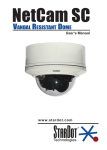


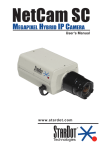
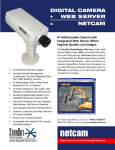



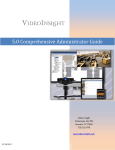
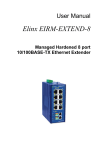
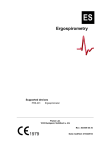
![Front End Risk Adjustment System [ FERAS ] User](http://vs1.manualzilla.com/store/data/005730281_1-6f4c2bdb0bfee36132bd7754fa830eb4-150x150.png)
